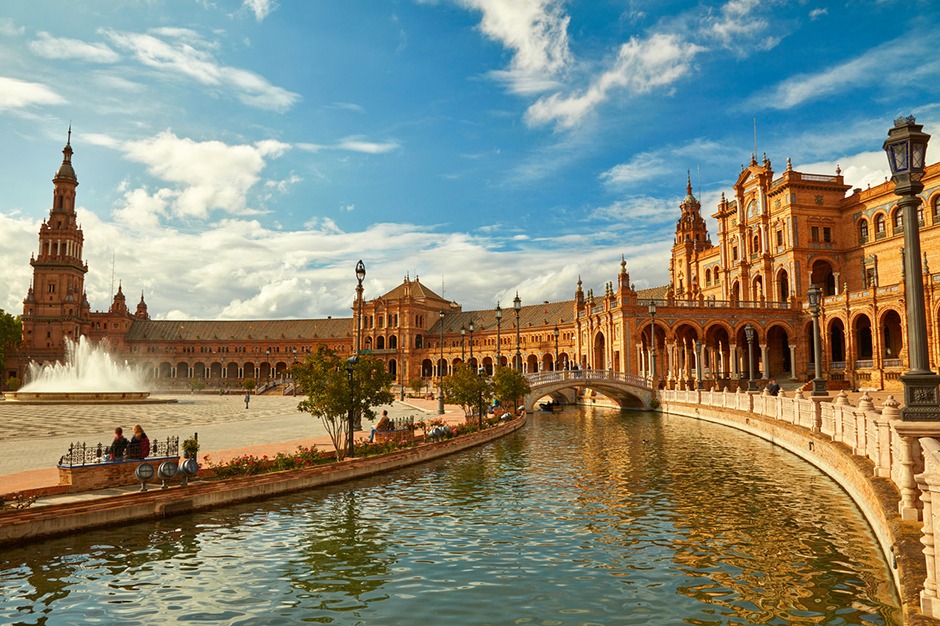
Renowned for their Moorish roots, Seville, Córdoba, and Granada are easily connected by high-speed rail, making them ideal for a short trip
In Granada, lunchtime is a busy time. At the well-known, classic tapas tavern Bodegas Castaneda, by 3 p.m., every available space at the packed bar counter is taken. Orders are given by waiters who weave amongst standing patrons while holding platters of hot croquetas and rose-pink jamón serrano above their heads. Cold glasses of fino are passed by, and plates of golden calamari and tortilla Española clink and clatter.
We’ve come to try the Bodega’s famous Calicasas, a concoction of vermouth, gin, rum, soda, and spices. We savour a substantial array of regional cheeses and jamón serrano while sipping it leisurely. We’ve just had one glass between us, but already we’re comfortable with the vibrant atmosphere and want to stay all day. We’re tempted to have another glass, but our packed schedule leaves no time for relaxation; there’s too much to see in our two days in one of the most fascinating cities in Spain.
Our third stop on the popular road that winds through the parched landscapes between three of Spain’s most notable towns is Granada. Few places in Europe have as fascinating a hinterland as this one; the southernmost portion of Spain was the final stronghold of Moorish sovereignty, falling under Islamic dominion from the early eighth century until Granada was taken over by Catholic rulers in 1492. The extraordinarily rich heritage of palaces and mosques that still stand in Seville, Córdoba, and Granada provide insight into the Moorish impact and scope of their dominion.
High-speed train links connect these three cities conveniently, with travel times of no more than two hours. After that, a short connection takes us down to Málaga, where we spend a night by the sea to begin and complete our journey. Málaga is a vibrant city that looks like a cross between Brighton and Nice. It has an old town full of eateries and a waterfront lined with palm-tree-filled, lush parks. It is an excellent way to become acquainted with Andalucía. But when we get off the train in Seville, we realise we’ve arrived somewhere very different from the laid-back, beachside charm of Málaga.
In most cities, the cathedral would be the top draw, but in Seville, the Alcázar—a vast royal palace with a thousand-year history—grabs the show

Seville’s winding streets are a big draw; throngs of tourists converge on the enormous cathedral, the biggest Gothic church in the world. Church officials are said to have pledged at the cathedral’s founding to build “a cathedral so stunning and grand that those who see it completed will deem us insane.” The achievement is still astounding 500 years later. Turning slowly around 360 degrees beneath the majestic vaulted ceiling decorated in burnished gold is the finest way to appreciate the vast space inside. Encircled by eighty side chapels, many of which are large enough to function as independent churches, dozens of statues and sculptures, and the world’s largest altarpiece, the stunningly vast retablo, which was crafted over the course of a lifetime by one craftsman, Pierre Dancart.
In most cities, the cathedral would be the primary draw, but Seville has something extra special to offer: the Alcázar, a vast royal castle with a rich 1,000-year history. Originally constructed in the tenth century as the home of the Córdoba Moorish caliph, it later became one of Europe’s most exquisite Renaissance palaces and was occupied by the Bourbon kings.
I am fascinated by the complex history of Andalucía as we stroll through elegant courtyards decorated with Mudéjar design, past lavish baroque tapestries and Renaissance treasures. Everything about this place feels like a rich tapestry of history: Moorish elements are still visible in every church and castle, but Catholicism prevailed over Moorish influence and Romanesque architecture preceded Renaissance.
Though the Alcázar is spectacular, the gardens really take centre stage with their vivid hot-pink bougainvillaea blooms, tall palm trees, and air-refreshing fountains that let us roam about.
Two days seem short in Córdoba to see everything there is to see in Seville. The following morning, we get off the train and go onto a wide avenue that leads us into the labyrinth of streets that make up the old centre. Much smaller than Seville, Córdoba is easy to get around in, and we quickly get settled into our accommodation. Before long, we’re sipping cold beers on a charming street lined with whitewash, where the centuries-old history seems to be permeating every inch of the space.
Maybe it’s the Mezquita, the massive mosque that stands out in the historic centre and was built at the time when Córdoba was the centre of Moorish rule. Entering the space is like stepping into a maze of windows with azure stripes that span across an enormous area, row after row. But the real wonder of the Mezquita is still to come: King Ferdinand II constructed a fully fledged Gothic cathedral inside its walls during the Reconquista. It is believed that this incorporation makes a stronger signal about Catholic authority than the mosque’s simple demolition.
By the time we reach Granada, it’s hard to think we could possibly experience anything more magnificent. Still, the Alhambra exceeds our expectations with its shining white marble terraces and magnificent Arabesque stucco work adorning its courtyards and palaces. There are throngs and tour groups here, but overall there’s a calmness about the place.
Every city we visit has a strong connection to its Moorish past, but Granada has a particularly alluring quality, in part because of its thriving student population, which gives the city a fresh and genuine feel. A little portion of Granada’s vibrant personality is related to tourism.
When we finally get back to Málaga, it seems like we’ve travelled considerably further than the two hours we spent on the bus. Rather, we have come from a far-off and luxurious realm that evokes memories of its past magnificence.



